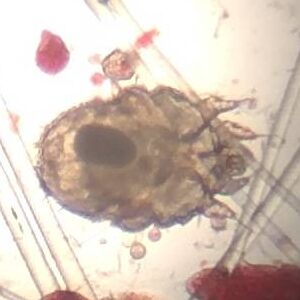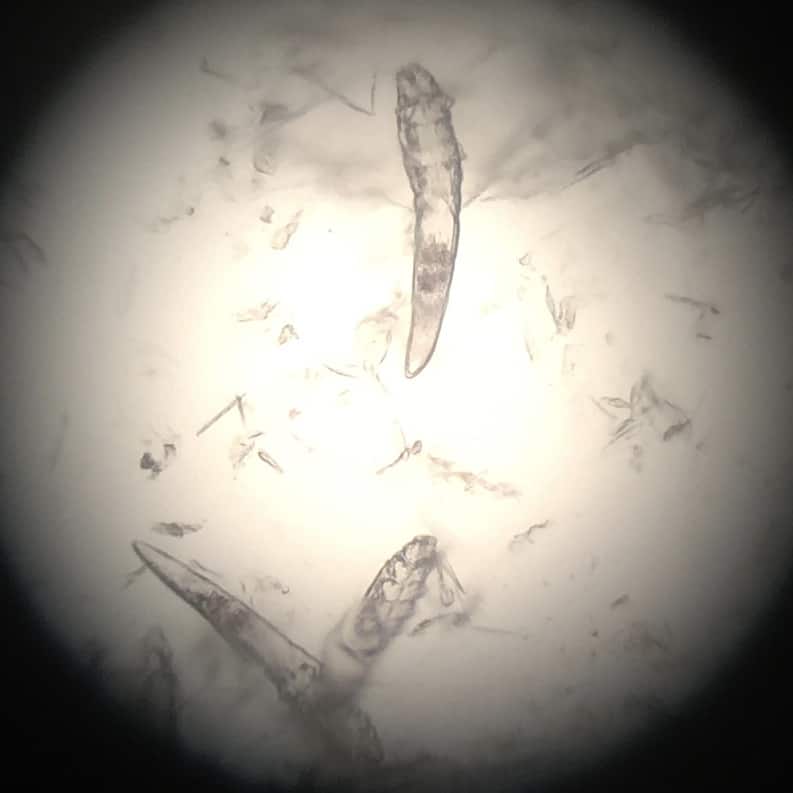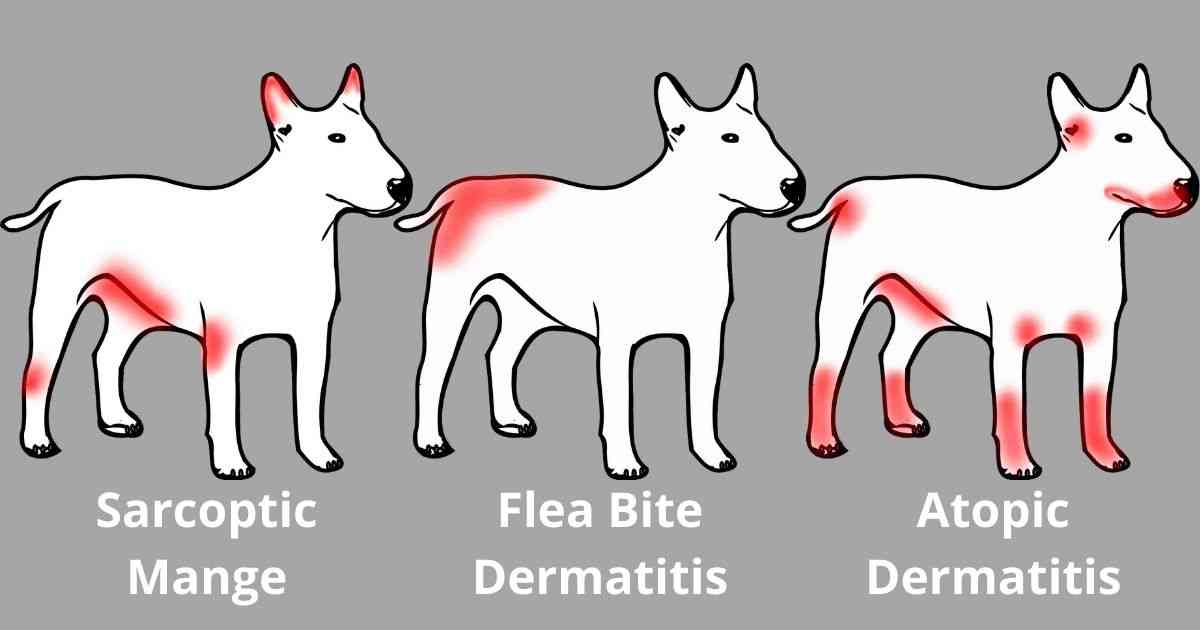Updated November 24, 2023
If you have an itchy dog, it gets very frustrating very quickly. Nothing seems to help for long, and everyone tells you something different. Is it the food, is it grass, is it mites?
This is an opinion piece, not a regular clinic article. I have been seeing itchy dogs for nearly 30 years and have yet to see one who cannot be helped. Here I’m going to boil down all the conflicting advice into my simple step by step approach.
First, let’s define what makes an itchy dog.
Signs Of Pruritus In Dogs
The sensation of itchiness on its own (called pruritus) only causes the skin to look pinker than normal. That would be as far as it went if it wasn’t for two unavoidable consequences:
- Dogs are unable to resist the temptation to bite, scratch or lick at an itch
- Dog skin quickly gets secondary infections with opportunistic yeasts or Staph
It’s these two effects that really create the typical appearance of an itchy dog. This could be any of the following:
- Ear infections
- Licking the feet and chewing at the paws
- Red-brown saliva staining in the coat
- Hotspots and skin infections
- Hair loss and a doggy smell
- Thickened or black skin
8 Steps To Stop A Dog Scratching
The following is my approach towards a more comfortable dog, and could be your pathway too. Each is a trial: we keep what works, and keep going until everybody’s happy. Some steps are for you alone, others are in partnership with your vet.
When I do this in my clinic I will often change the order or overlap the steps depending on the situation. Your vet is likely to do this a whole different way, and that’s fine too.
Step 1: Eliminate Secondary Infections
Stopping a dog from itching, scratching or biting is impossible if there’s any secondary infection or if they are in a vicious cycle of repeated damage. Therefore, you need to see a vet straight away if there are signs of the following:
- Broken, moist or greasy skin
- Crusts or scabs
- Red bumps, pimples or rings
- Smelly or mucky ears
Then come back to this list!
Step 2: Parasite Control

Let me be blunt. There is no place for “my dog is scratching but he doesn’t have fleas“. Not in an age of excellent, affordable flea control. Especially not when mange mites can be eliminated in the same step.
Allergic dogs carry fleas in numbers that are too low to detect, and you’ll never see mites. Therefore, whether you believe in it or not, please, please start out by using a good parasite prevention. Think of it like an insurance policy.

I personally only use one of:
- Simparica
- NexGard
- Credelio
- Bravecto
You can view a larger list of registered dog flea products here. These products can be game-changers for itchy dogs.
Step 3: Shampoo
Never underestimate the effect of bathing done properly. The myths about bathing dogs too often are outdated and based on bad shampoo choices. Every dog should get the opportunity to see if bathing can help.
Bathing will work if it can remove the offending allergen or irritant without disturbing the skin’s barrier function. I ask owners to use soap-free shampoos like Aloveen at least once a week, but preferably twice. For yeast I will use Malaseb.
Dogs prone to ear infections often benefit from a flush with the right ear cleanser afterwards.
Then there are the moisturisers. Each good shampoo company has a matching conditioner or spot-on treatment. These aren’t always necessary, but definitely worth trying.
Step 4: Food (Part I)
I’ve discussed before the reasons why food is over-hyped in itchy dogs, but it still plays an important role, twice.
Here and now, we want to try food as a form of medicine. So I ask you to use a diet specifically formulated to reduce itch in dogs. These are not quite elimination diets. Three examples are:
- Royal Canin Skintopic
- Hills Sensitive Skin
- Hill’s Prescription Diet Derm Complete
Skin foods work by containing all the known nutritional supplements that can help reduce itch in dogs. They are not spectacular, ever, but they always help a bit.
If you don’t want to change the diet, then at a minimum add fish oil to the diet at a rate of one gram per 4.5kg bodyweight. Stop immediately if it causes tummy upsets.
Step 5: Corticosteroid Trial
After all this is done (and still being done) I will sometimes try a short course of prednisolone. You can read more about the approach here, but what I’m looking for is that third of dogs who will tolerate its side effects while achieving relief of symptoms.
Here I’m getting controversial, and in fact I skipped this step with my own Jack Russell. However, if you can get it to work, prednisolone is a far, far cheaper option than what is to follow.
Another way of using corticosteroids is via creams, lotions, sprays and ointments. These often cause more harm than good due to dogs licking them off, but they can be helpful for small areas.
Step 6: Food (Part II)
A lack of response to prednisolone at regular doses pushes food allergy higher up the list, enough to justify the next step. Now we perform a strict elimination diet. These are not for the half-hearted as you’ll see at the link.
I am very tired of seeing poor dog owners who’ve been told at the beginning that their dogs have a food allergy (usually wrong) and then put on a different food (that almost never works). I often only learn of this six months later after they’ve given up.
There is a widespread lack of understanding about what constitutes an effective food trial. Just changing brands it is certainly not. It’s an eight-week highly controlled diet with very limited chances of success. That’s why it’s this far down the list: important to rule out, but not high priority.
Step 7: Cytopoint or Apoquel
At this point, we’re out of simple options, and the problem looks like it’s here to stay. Only five years ago, such dogs had only Atopica, but now we have two more effective choices:
- Apoquel is a tablet that suppresses a range of inflammatory cytokines involved in inflammation
- Cytopoint is a monoclonal antibody injection that binds to interleukin-31 and prevents it initiating inflammation
These drugs are generally well-tolerated and extremely effective. I find that both work best if they are started early in the course of dermatitis, before secondary skin changes develop. The disadvantage of both is price; indications of each can be found at the links.
Step 8: Referral
If all the treatments we’ve tried so far haven’t given enough relief, now is the time for a veterinary specialist dermatologist. Hopefully you’re lucky enough to have one nearby. Here in Adelaide we can arrange referral to one of two vets who deal exclusively in skin problems.
Of course. this step doesn’t have to be last. At any stage you can ask for referral, and we will happily provide it. However, my own approach is to pick all the low-hanging fruit I can before sending you away.
Costs only go up, which means this isn’t for everyone. But it’s usually worth at least just taking the first appointment to see if there’s anything simple that’s been missed.
Other Options
These 8-steps are a very individual approach. Not unconventional, just my personal take on a complex problem. Here are some other treatments you’ll also get advised:
- Antihistamines are often added early in the process. I don’t think they work very well, but I can’t criticise the attempt. We’re all trying our best.
- Natural remedies are heavily promoted online. You are welcome of course to try them but we see very little effect.
A Plug For Insurance
I once heard from a pet insurance company that their number one payable condition is dermatitis, and I’m not surprised. But if your dog already has symptoms, it’s too late to get them covered. This is what we call the pre-existing condition exclusion.
Therefore, if you’re the owner of a young, healthy dog, do consider pet insurance. I can think of no better example of its effectiveness than all the dogs with atopic dermatitis. If your dog is unlucky enough to get it, then insurance means being able to take all these steps without hesitation.
Even if this isn’t an option, and funds are limited, a way can usually be found to make your dog comfortable again. So don’t suffer in silence!
Related: The Causes Of Atopy In Dogs | A List Of Dog Skin Medications
Have something to add? Comments (if open) will appear within 24 hours.
By Andrew Spanner BVSc(Hons) MVetStud, a vet in Adelaide, Australia. Meet his team here. The information provided here is not intended to be used as a substitute for going to the vet. If your pet is unwell, please seek veterinary attention.


Hello Andrew, thank you for sharing your Knowledge, it is if great assistance to people on an income that doesn’t allow for vet visits as often as one would. Just having the opportunity to ask questions without the consultation fees therefore allowing us to keep our pets healthy with the minimum amount of visits is of huge value and my dog for one can’t thank you enough.
Stacie was a rescue so know little about her past. She has terrible skin issues …greasy but flaky skin and hair loss. Constantly itching. Get her cytopoint injections regularly but the smell is so horrible we can hardly bear it! I wash her every other day in medicated shampoo…yes, tried many but veterinary formula worked best. She smells like a combo of vomit and cow manure. It must be coming from her gut to skin but I have spent hundreds of dollars at the vet to no avail! She has been on meds for yeast, been wormed regularly and multiple varieties of good in case of food allergies. I need major help!!
Thanks for the advice. We have a West Highland Terrier 10 years old. She has had a bad run with skin and ear infections. We are well into 4 + months of the strict diet – all aimed at a supposed allergy to proteins. She has also been on two long rounds of antibiotics for the yeast skin infection. She stinks – even after a bath (Malaseb) and her skin and fur is terrible. Pre the diet she was on Apoquel which seemed to help the itching but she still had regular ear infections. I feel the food is not the issue and now causing her smell problem and not helping her skin. Any thoughts?
Hi Andrew. Simply looking at the odds, food is a less likely cause of skin disease. Environmental allergens and secondary infections predominate, especially in Westies. Four months is plenty of time to have done a food trial and so I would go back to what has been working before.
Hi I’m in the uk and this post is extremely interesting. I have tried most things on here . Baths Elimination diets and loads all natural treatments and apoquel which has a bad rep
Here . It’s not as effective but am about to try masaleb shampoo. It’s have a frenchie . Wuxi he bites licks paws bad and scratches face . Now started to do his sides I’m
Desperate. Hope you be to read this .
Hi Samantha. It will be difficult for you if your dog has severe atopy without pharmaceuticals, so if the reputation you are hearing is from online chatter, talk to a veterinary professional. They should be able to set your mind at rest. For the right dog, these new drugs are game changers and has brought dramatic improvements in dog welfare. Especially for French bulldogs.
I’ve read a lot of comments about allergy in dogs elsewhere on your site. My lovely Staffie has had very red and sore paws for a while now. I really only came to know of what was wrong when I could see it was not a sore foot from running too much but an allergic reaction. They were infected, so the vet prescribed antibiotic and Malaseb medicated shampoo twice weekly (feet only) for 10 days. (my memory does not serve me well of this exact regime with Shampoo. It all settled very well initially but then started over again and in the meantime using the Malaseb again and massaging it in between her paws, I felt I may have torn her skin?) Back to the vet and the antibiotic dose was changed to a larger dose, advised not to use the Malaseb and prescribed Apoquel. This worked including no walking both times until the paws appeared healed. Yet since then I have had to resort to giving the Apoquel as needed and mostly it seems to be needed. Her paws are so sensitive, and a walk aggravates them in no time. I’ve not ever over bathed her and notice you suggest twice weekly. I was told the Malaseb can be drying so I’m hesitant to use it regularly. I’ve been using a Natural Ingredient Dog Soap Bar – unscented. Staffie is just 6 but has always had hair loss down her spine and on her tail. Beyond this background why is it that no-one seems to recommend dog boots?
I did buy some but have had to return them as wrong size. Not sure whether to buy smaller size. She looked like a human being looks walking with flippers, so funny. I would be interested in your input if you have time. I’m in Victoria and was told allergies were worse during Covid as grasses were not cut as regularly as usual in parks. I think in hindsight the allergy had been brewing for some time
Hi Glenda. No one recommends dog boots because the problem isn’t really about the feet, it’s about the skin as a whole with the feet being a focus of the reaction. You could possibly make it worse by enclosing inflamed feet.
If you look at the diagram at the beginning of the article, you’ll notice that hair loss down the spine and on the tail is associated with flea bite. It’s such an easy thing to rule out, and never, never assume that not seeing them means they’re not there. That’s why it’s very high on this list.
In your case when using Malaseb, you only need to do the feet, and then treat the rest of the body with a milder shampoo like Aloveen. The shampoo you recommend is probably not up to scratch despite the use of the word ‘natural’ (which has very little meaning anyway). We’re looking for a detergent-free shampoo here.